Ocean Newsletter
No.551 July 20, 2023
-
The Role of the Arctic Circle and the Success of the Japan Forum
Olafur Ragnar GRIMSSON (Chairman of the Arctic Circle, President of Iceland, 1996-2016)
The Arctic Circle Japan Forum, convened in Tokyo in March 2023, co- hosted by Sasakawa Peace Foundation and The Nippon Foundation, was on many levels a great success. The Arctic Circle Assemblies and Forums are open democratic platforms. With multiple Forums in the world, the Arctic Circle has become one of the most significant global platforms in the 21st century.
-
The Arctic Circle and Natural Dyes
SAKAGUCHI Hide (President, Ocean Policy Research Institute, The Sasakawa Peace Foundation)
At the Arctic Circle Japan Forum flower arrangements were showcased as an example of Japanese traditional culture. The flower materials were mostly collected from the wild. After the forum, they were taken back home and reused, then reclaimed for natural dyes, and the rest were returned to the wilderness from which they were originally collected. These actions are exactly the embodiment of reincarnation and are the truest form of sustainability, which is the heart of the Arctic Circle. However, in reality, in the Arctic, the natural dyes are affected by global warming, which casts a shadow over the domain of traditional cultures.
-
A New System for the Promotion of “Umigyou” in Fishing Ports ~Revision of the Act on Fishing Ports and Grounds~
UCHIDA Satoshi (Disaster Prevention Planning Officer Fishing Ports and Grounds Improvement Section Fisheries Agency)
While maintaining the purpose of fishing ports as being to facilitate fishing industry activities, the Act on Fishing Ports and Grounds has been revised, creating a system that enables “umigyou” activities to be developed that promote the value and attraction of the ocean and fishing villages, revitalizing the fishing industry and fishing village life. This article introduces the schemes that will systematically implement projects for increased consumption of marine products and familiarity among the general public, based on understanding and cooperation from the local community and the necessity to secure ports’ use by the fishing industry.
The Role of the Arctic Circle and the Success of the Japan Forum
Japan Forum
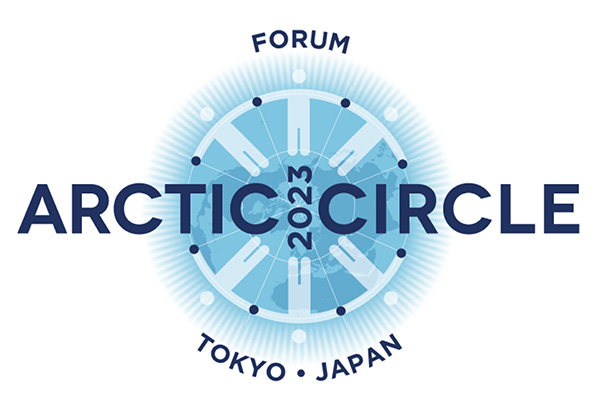
(Figure1) Logo of the Arctic Circle
The Forum demonstrated the determination by Japan to enhance its Arctic engagement, signalling with the construction of a new research vessel with icebreaker capabilities, the formidable contribution of Japanese science to increased knowledge regarding the Arctic, the climate and the state of the Northern Oceans.
The leadership provided by Japan was also manifested in clear and comprehensive statements by numerous Ministers in the Government of Japan and prominent Members of the Japanese Parliament. This strong political representation would in itself have made the Forum historic, but there were also other significant levels of success.
The Importance of Asia in the Arctic
All the Asian Observer States in the Arctic Council*2 – China, India, Korea, Singapore, as well as Japan – sent high level representatives to the Forum. In speeches and numerous dialogues they all conveyed the determination of their countries to play an even greater role in Arctic affairs. So formidable were their contributions during the Forum that the combined significance of these states became increasingly referred to as “The Asian Five,” thus recognising their highly important role in Arctic cooperation, and perhaps also playfully and indirectly linking that name to the “Arctic Seven,” now used to refer to the seven Arctic States which after the invasion of Ukraine paused their involvement in Arctic Council operations during the Russian Chairmanship.
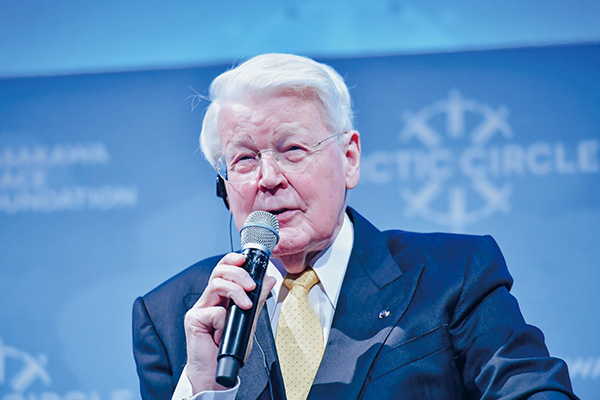
(Photo) Speech at the Japan Forum
The discussions at the Japan Forum were also broadened by many high-level representatives, scientists and experts from Europe and America. The dialogues between the various Asian participants and the Western delegates brought home the truly international nature of the Forum.
Although the title of the Forum was “Asia in the Future of the Arctic“, the informative and constructive contributions by multiple non-Asian experts, scientists, diplomats, and political leaders made the Forum truly a global event, proving how the Arctic Circle in cooperation with the Japanese hosts succeeded in broadening the field and the substance of Arctic cooperation.
The future of the Arctic Oceans was, together with the historic Central Arctic Ocean Fisheries Agreement*3 and various aspects of ocean research, among session topics on the opening day. Issues covered in other sessions throughout the Forum included Arctic Governance, the link between the Arctic and Third Pole/Himalayan region, Canadian Arctic Policy for the Indo-Pacific, Indigenous Knowledge in the Melting Arctic, Arctic Marine Conservation, Critical Minerals for the Green Revolution, Far North Fiber and Smart Cable as well as many more. Altogether, 50 sessions were held during the three days of the Forum; all were very well attended with lively discussions and penetrating questions. Over 300 participants from 25 countries attended the Forum, thus making it unique among Arctic gatherings in Asia.
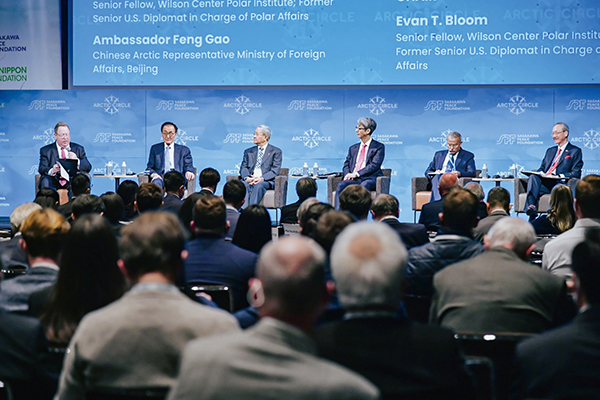
(Photo) Session attended by Arctic Ambassadors from “The Asian 5”.
The Significance of the Arctic Circle and Future Prospects
Since the Arctic Circle was founded ten years ago, the annual Assemblies have become by far the largest annual international gatherings on Arctic Affairs and related climate concerns, oceans, glaciers, technology, economic development, and governmental cooperation. The Assemblies are also attended by hundreds of young activists, students, and non-governmental leaders, exercising their democratic right to influence the future of the Arctic and our Planet.
The Arctic Circle Assemblies and Forums are open democratic platforms where different entities can organise sessions, events and dialogues; where anyone with something to say irrespective of formal status or activist position, young or old, can both be heard and influence the discussions; where leaders are questioned and countries present their policies and plans to be examined in critical ways.
With multiple Forums in America, Europe, Asia, the Middle East, and the Assemblies in Iceland, the Arctic Circle has become one of the most significant global platforms in the 21st century. The Forum in Japan demonstrated this in fascinating ways. Its success was in a large measure due to the excellent organisation provided by Sasakawa Peace Foundation and The Nippon Foundation under the leadership of Dr. Atsushi Sunami and Chairman Yohei Sasakawa. The dedication of their staff in the months, even years, leading up to the Forum and during the critical days was a testimony to Japanese professionalism, culture, and traditions. The Arctic Circle is profoundly grateful and honoured by our partnership with such distinguished organisations and looks forward to further cooperative endeavours in the years to come.
- *1Arctic Circle is the world's largest non-governmental organization (NGO) on the Arctic, founded in 2013 at the initiative of the author of this article. An annual meeting is held every fall, and regional forums are held irregularly in conjunction with governments and NGOs interested in the Arctic. At both of these, government officials from Arctic as well as non-Arctic countries, and indigenous Arctic groups, private companies, NGOs, research institutes and researchers, as well as other stakeholders from around the world come together to discuss Arctic issues. The Japan Forum held in March was one of the regional forums for this year. (Cf.) Arctic Circle website https://www.arcticcircle.org/
- *2The Arctic Council was established in 1996 by the eight Arctic nations (Canada, Denmark, Finland, Iceland, Norway, Russia, Sweden, and the United States) to discuss Arctic issues among high-level government representatives.
- *3Agreement to Prevent Unregulated High Seas Fisheries in the Central Arctic Ocean (signed in 2018, entered into force in 2021)
Underwater archaeology is the field of study that seeks to unravel the mysteries of history from ruins lying at the bottom of the sea. Born in the Mediterranean in the 1960s, this new branch of archaeology reveals unique episodes from our past. This article introduces the fascination behind sunken shipwrecks - a unique type of ruins - and the significance of researching them.
What is Underwater Archaeology?
With its beginnings in the excavation and research of ancient shipwrecks in the Mediterranean in the 1960s, underwater archaeology is now regarded as an essential field of archaeological research in many countries around the world. Why is this a field of interest? It is because the archeological sites which serve as the research subject exist in unique underwater environments. The most significant feature of underwater archaeology is how well the ruins are preserved. For example, if a ship from the ancient Roman period 2,000 years ago ran aground in a storm and sank onto a sandy seafloor, the weight of the cargo and the currents would cause the sand to cover it, creating a unique environment where the shipwreck is buried in the sand. As a result, the environment surrounding the wreck is free of oxygen, preventing marine organisms and bacteria from proliferating. Consequently, even organic materials such as wood can be preserved in almost perfect condition for 2,000 to 3,000 years or more. It is not uncommon for shipwrecks to be discovered in excellent condition, as if they had sunk just yesterday. Therefore, many underwater ruins excavated from the seafloor possess more valuable information than those on land, often having high academic value. This is why underwater archaeology attracts so much interest among Western archaeologists.
Sunken Shipwrecks
In addition to the cargo, the sunken ship's hull is also an essential subject of archaeological research. Professor George Bass (1923-2021), known as the father of underwater archaeology, was quoted as saying, "Before there were farmers or shepherds, there were seafarers." This statement indicates the importance of ships in the birth and prosperity of human civilization, as evidenced by the fact that humans had already reached remote islands and continents such as Australia long before the advent of agriculture. By studying the remains of ships, we can learn about the technological levels of civilizations and nations at the time. For contemporary archaeologists, studying the structures of ancient ships is synonymous with future archaeologists studying the technology of 21st-century nuclear submarines and the International Space Station to understand our current technological level.
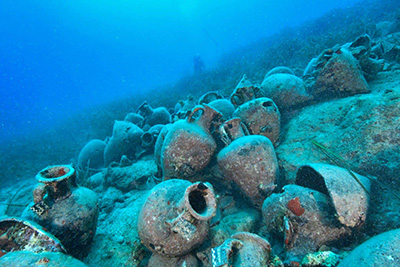
A cargo of amphorae from a sunken, ancient Greek (4th century B.C.) ship found in Croatia.
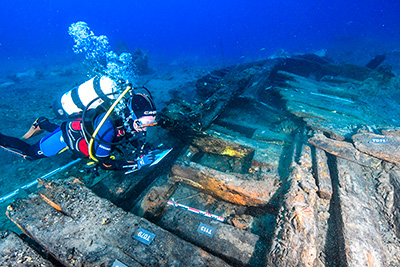
A 16th-century Venetian Republic shipwreck under excavation in Croatia
Challenges in Underwater Archaeology
In the case of underwater archaeology, the excavation site is underwater, so work must be done while scuba diving. Underwater, the compressed air we breathe causes nitrogen to accumulate in our bloodstream above normal, which can lead to potentially lethal decompression sickness when surfacing as pressure decreases, forming bubbles and blocking the blood flow. Therefore, the time spent on underwater work is much shorter than that spent on terrestrial archaeological excavations. For example, at a depth of 30 meters, diving work is limited to about 30 minutes per session, two times a day, for safety reasons. Recently, photogrammetry (measurements using photography) and digital 3D modeling technology have helped improve this situation1. Moreover, underwater archaeologists worldwide are putting these technologies to the test to verify the usefulness in various applications.
The Future of Underwater Archaeology in Japan
This is because Japan has a world-class system for protecting and managing terrestrial ruins and a top-level standard of archaeological research in the world. Each municipality has a Buried Cultural Properties Division staffed with experienced archaeologists well-versed in the history of local terrestrial ruins3. There are approximately 6,000 archaeologists working as public servants throughout Japan. If even one in 100 of them were to obtain a diving license and begin investigating underwater ruins, the field of underwater archaeology in Japan would flourish rapidly. What kind of history has Japan, a country surrounded by the sea, experienced in its interactions with other countries? The keys to solving this mystery await our discovery at the bottom of the sea. (End)
1. Kotaro Yamafune, "The Underwater Archaeologist and the Tale of the Seven Seas"
https://suichukoukogaku.com/photogrammetry-and-underwater-archaeology/
2. Akifumi Iwabuchi, "Marine Cultural Resource and the UNESCO Convention on the Protection of the Underwater Cultural Heritage,"
No. 344 of this newsletter (December 5, 2014)
3. Kohei Sugiyama, "What Land-based Archaeologists Are Seeking among Our Underwater Cultural Heritage,"
No. 467 of this newsletter (January 20, 2020)
